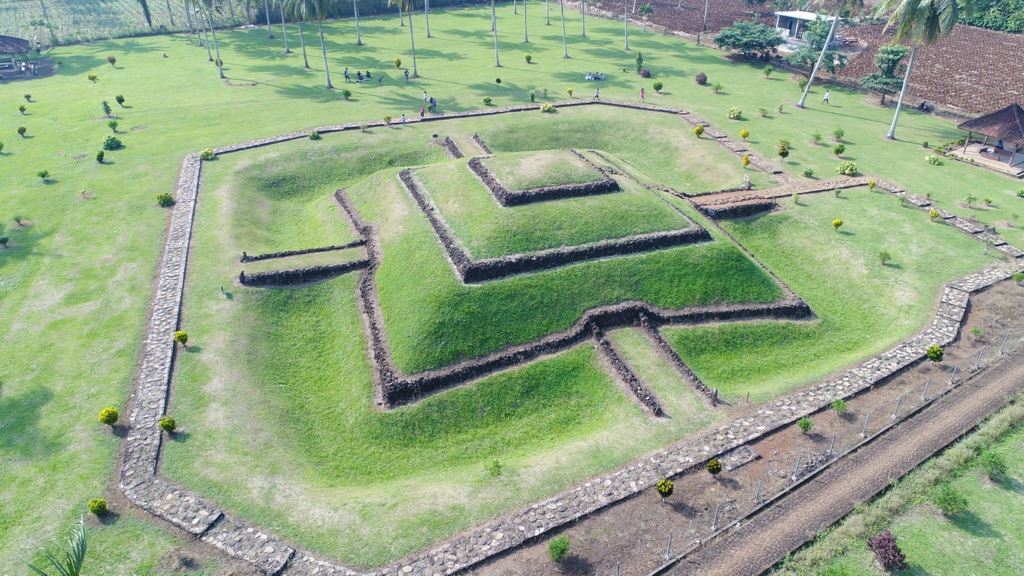The Pugung Raharjo Pyramid is an enigmatic site located in Lampung, Sumatra, Indonesia. It’s a complex of ancient megalithic structures, often referred to as a pyramid due to its shape. The site includes various artifacts such as stone tablets, terraces, and burial sites. It’s believed to date back to the prehistoric era, with some estimates placing it around 2,500 years old. The pyramid remains a subject of fascination for both tourists and researchers alike, offering a glimpse into Indonesia’s ancient past.
Get your dose of History via Email
Historical Background of Pugung Raharjo Pyramid
The Pugung Raharjo Pyramid was discovered in the 20th century, although the exact date remains unclear. Local inhabitants have long known about the site, but it gained academic attention when researchers began studying it in earnest. The pyramid is thought to have been built by the indigenous Lampung people. Over time, it has seen various groups pass through, each leaving their mark on the site.
Archaeological evidence suggests that the site was not only a spiritual and ceremonial center but also a settlement. It has yielded numerous artifacts that provide insights into the daily lives of its inhabitants. The pyramid’s construction techniques and the artifacts found there suggest a complex society with advanced knowledge of astronomy and engineering.
While the original builders are believed to be the Lampung people, the site does not appear to have been continuously inhabited. It may have been abandoned and later rediscovered by subsequent cultures. The pyramid has not been the scene of any known historically significant events, but its existence is significant in understanding the region’s prehistory.
The site has not been extensively excavated, which means much of its history remains shrouded in mystery. However, the artifacts and structures that have been uncovered point to a sophisticated culture with its own beliefs, customs, and social structures. The Pugung Raharjo Pyramid stands as a testament to Indonesia’s rich and diverse history.
Research into the pyramid is ongoing, with Indonesian archaeologists and historians working to uncover more about the site’s origins and purpose. As excavations continue, it is hoped that more light will be shed on this intriguing piece of Indonesia’s past.
About Pugung Raharjo Pyramid
The Pugung Raharjo Pyramid is a complex of megalithic structures made from volcanic rocks and stones. The site includes a series of terraces, which lead up to the pyramid-shaped main structure. The construction methods reflect a deep understanding of stonework and engineering, characteristic of megalithic cultures.
The pyramid itself is not a true pyramid in the Egyptian sense but rather a terraced structure with a flat top. The building materials were sourced locally, and the design is thought to have astronomical alignments. These alignments suggest that the pyramid may have had a calendrical or astronomical purpose.
Architectural highlights of the site include stone altars, menhirs (standing stones), and dolmens (stone tables), which are scattered around the pyramid. These features indicate that the site was used for ceremonial purposes, possibly including rituals related to agriculture, fertility, or the afterlife.
The construction of the Pugung Raharjo Pyramid would have required a significant labor force, suggesting a well-organized society. The precision of the stonework indicates that the builders had a sophisticated understanding of stone-cutting techniques and architectural design.
Despite its age, the pyramid has remained in relatively good condition, although some restoration work has been necessary to preserve the site. The Indonesian government and cultural preservation organizations have taken steps to protect and maintain the pyramid for future generations.
Theories and Interpretations
Several theories exist about the purpose and significance of the Pugung Raharjo Pyramid. Some researchers believe it was a religious or ceremonial site, while others suggest it may have served as an astronomical observatory. The alignment of certain structures with celestial bodies supports this theory.
There are mysteries surrounding the pyramid, particularly regarding the symbols and carvings found on some of the stones. These have been interpreted in various ways, but without definitive evidence, their meanings remain speculative. Some scholars have attempted to match these symbols to historical records from other parts of Indonesia and Southeast Asia.
Dating the pyramid has been challenging due to the lack of organic material that can be carbon-dated. However, estimates based on the style of the artifacts and the wear on the stones suggest it is at least 2,500 years old. More precise dating methods are needed to confirm this.
The site’s discovery has prompted comparisons with other megalithic sites around the world. Some have speculated about cultural exchanges between different regions in ancient times, which could explain similarities in construction techniques and designs.
As research continues, new theories and interpretations emerge, adding to the depth of knowledge about the Pugung Raharjo Pyramid. Each discovery contributes to a more nuanced understanding of this ancient site and its place in Indonesia’s history.
At a glance
Country: Indonesia
Civilization: Indigenous Lampung people
Age: Approximately 2,500 years old

